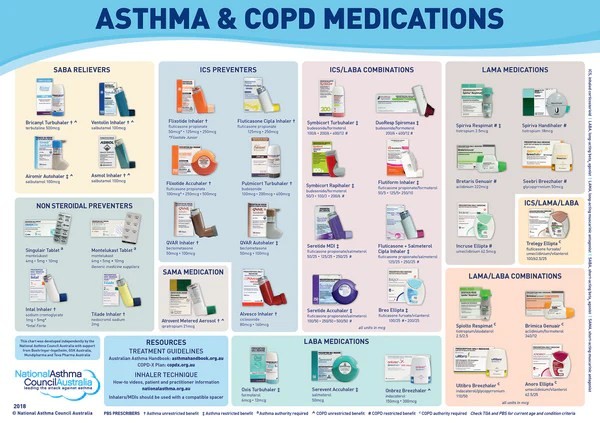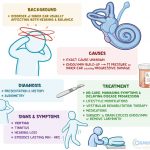
Contents
Asthma Medications
Any patient diagnosed with asthma is a candidate for asthma medication.
- Patients with mild, infrequent asthma symptoms may only need albuterol (Ventolin HFA, Proventil-HFA, Vospire ER, ProAir HFA, ProAir, RespiClick) as a rescue medication.
- Patients with more frequent asthma symptoms require daily medications.
The choice of medication depends on asthma severity.
What are controller medications for asthma (long-term control)?
Controller medications are daily medications used to prevent or improve asthma symptoms in patients with frequent symptoms. The decision to use controller medications is based on:
- Frequency and type of symptoms
- Frequency of medical visits
- Frequency of rescue medication use
- Frequency of oral steroid use
- The impact of symptoms on daily life
- Breathing tests performed in the medical office
Inhaled corticosteroids are generally the first-line therapy for patients requiring controller medications.
What are rescue medications for asthma (short-term control)?
Rescue medication for asthma quickly opens the airways and provides relief from symptoms such as chest tightness, shortness of breath, cough, or wheezing.
Rescue medications for asthma include:
- Albuterol
- Levalbuterol (Xopenex)
- Ipratropium (Atrovent)
Albuterol is the most commonly prescribed rescue medication. Levalbuterol is similar to albuterol but may cause less restlessness. Ipratropium is used with albuterol for emergency asthma treatment or in patients unable to tolerate albuterol or levalbuterol.
What are the different forms of medications (pills, inhalers, nebulizers) to treat asthma?
Many controller and rescue medications are administered through asthma inhalers. Some inhalers are metered-dose inhalers that propel the medication, while others are breath-actuated inhalers. Both types are effective if used correctly.
Nebulizers deliver asthma medications in an aerosolized form through a mouthpiece or mask, often used for children. Some medications are available as pills. Injectable medications (omalizumab [Xolair] and mepolizumab [Nucala]) and an intravenous medication (reslizumab [Cinqair]) are administered in a healthcare setting. Injectable and intravenous options may become more common in the future.
What are the names of asthma medicines?
The first-line controller medications for asthma are inhaled corticosteroids, such as fluticasone (Flovent and Arnuity Ellipta), budesonide (Pulmicort), beclomethasone (Qvar), mometasone (Asmanex), and ciclesonide (Alvesco). Combination controller medications include a long-acting beta-agonist (formoterol, salmeterol, or vilanterol) in addition to inhaled corticosteroids, such as fluticasone/salmeterol (Advair) and budesonide/formoterol (Symbicort).
Leukotriene modifiers (montelukast, zafirlukast, zileuton) act on the immune pathway responsible for inflammation. Tiotropium may be used for patients needing combination therapy or those with a history of smoking-related lung disease. Theophylline improves bronchodilation and inflammation. Cromolyn is an alternative to inhaled corticosteroids for mild asthma.
Injectable medications (omalizumab) target allergic reactions, while two recently approved medications (mepolizumab and reslizumab) reduce eosinophil count. Oral steroids (prednisone, prednisolone, methylprednisolone, dexamethasone) provide prompt relief during asthma flares but have side effects.
Complete list of commonly used asthma medications
- Short-acting bronchodilators provide quick relief and can be used with exercise-induced symptoms, such as albuterol.
- Inhaled steroids are first-line anti-inflammatory therapy, such as budesonide, fluticasone, beclomethasone, mometasone, and ciclesonide.
- Long-acting bronchodilators can be added to inhaled corticosteroids but should never be used alone, such as salmeterol and formoterol.
- Leukotriene modifiers serve as anti-inflammatory agents, such as montelukast, zafirlukast, and zileuton.
- Anticholinergic agents decrease sputum production, such as ipratropium and tiotropium.
- Anti-IgE is used in moderate to severe allergic asthma, such as omalizumab.
- Anti-IL-5 agents are used in moderate to severe asthma with elevated eosinophils, such as mepolizumab and reslizumab.
- Chromones stabilize mast cells but are rarely used, such as cromolyn and nedocromil.
- Theophylline helps with bronchodilation but has side effects, such as Respbid, Slo-Bid, and Theo-24.
- Oral steroids are potent anti-inflammatory agents used during asthma exacerbations, such as prednisone, prednisolone, methylprednisolone, and dexamethasone.
While numerous new asthma medications are being studied, none are currently available for routine therapy.


